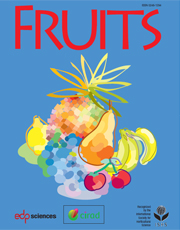Article contents
A set of data on green, ripening and senescent vanilla pod (Vanilla planifolia; Orchidaceae): anatomy, enzymes, phenolics and lipids
Published online by Cambridge University Press: 05 August 2010
Abstract
Introduction. Mature green vanilla pods accumulate 4-O-(3-methoxy-benzaldehyde)-β-D-glucoside (glucovanillin), which, upon hydrolysis by an endogenous b-glucosidase, liberates vanillin, the major aroma component of vanilla. Little is known on the spatial distribution of aroma-generating phenolics, and the enzymes responsible for their liberation (β-glucosidase) and oxidation (peroxidase). We report here quantitative data with respect to these three components in relation to the anatomy of the pod. Furthermore, the spatial progression of oxidation is shown. Materials and methods. Mature green vanilla pods were analyzed for their contents of phenolics (HPLC), and β-glucosidase and peroxidase activities by spectrophotometric techniques using p-nitrophenyl glucoside and vanillin as substrates, respectively. Lipids were examined under fluorescence microscopy after Nile red staining. Oxidation development was observed on transverse slices of pods. Results and discussion. Phenolics, and β-glucosidase and peroxidase activities showed gradients of increasing-decreasing concentrations from the stem to the blossom end of pods. The β-glucosidaseactivity is distributed in between the placentae, mesocarp, and trichomes in a [7 / 2 / 1] proportion while that of peroxidaseshows a [38 / 1] ratio inthe mesocarp and placentae, and was absent from trichomes. Oxidation begins from the blossom end in the placentae, progressively invading the mesocarp and moving towards the stem end. Conclusion. The green mature vanilla pod is spatially heterogeneous for its phenolics, and β-glucosidase and peroxidase activities, its placentae playing an important role in the liberation of vanillin and its subsequent oxidation.
Keywords
- Type
- Original article
- Information
- Copyright
- © 2010 Cirad/EDP Sciences
References
- 7
- Cited by




